英语语法 单一主语的主谓一致
- 格式:docx
- 大小:23.19 KB
- 文档页数:23
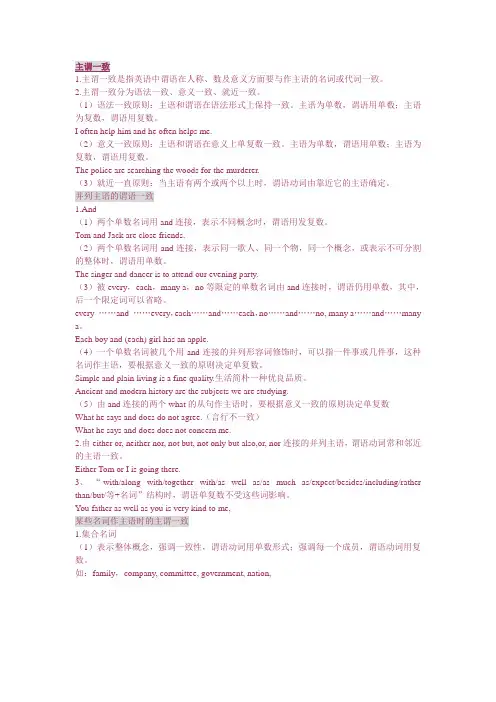
1.主谓一致是指英语中谓语在人称、数及意义方面要与作主语的名词或代词一致。
2.主谓一致分为语法一致、意义一致、就近一致。
(1)语法一致原则:主语和谓语在语法形式上保持一致。
主语为单数,谓语用单数;主语为复数,谓语用复数。
I often help him and he often helps me.(2)意义一致原则:主语和谓语在意义上单复数一致。
主语为单数,谓语用单数;主语为复数,谓语用复数。
The police are searching the woods for the murderer.(3)就近一直原则:当主语有两个或两个以上时,谓语动词由靠近它的主语确定。
并列主语的谓语一致1.And(1)两个单数名词用and连接,表示不同概念时,谓语用发复数。
Tom and Jack are close friends.(2)两个单数名词用and连接,表示同一歌人、同一个物,同一个概念,或表示不可分割的整体时,谓语用单数。
The singer and dancer is to attend our evening party.(3)被every,each,many a,no等限定的单数名词由and连接时,谓语仍用单数,其中,后一个限定词可以省略。
every ……and ……every,each……and……each,no……and……no, many a……and……many a。
Each boy and (each) girl has an apple.(4)一个单数名词被几个用and连接的并列形容词修饰时,可以指一件事或几件事,这种名词作主语,要根据意义一致的原则决定单复数。
Simple and plain living is a fine quality.生活简朴一种优良品质。
Ancient and modern history are the subjects we are studying.(5)由and连接的两个what的从句作主语时,要根据意义一致的原则决定单复数What he says and does do not agree.(言行不一致)What he says and does does not concern me.2.由either or, neither nor, not but, not only but also,or, nor连接的并列主语,谓语动词常和邻近的主语一致。
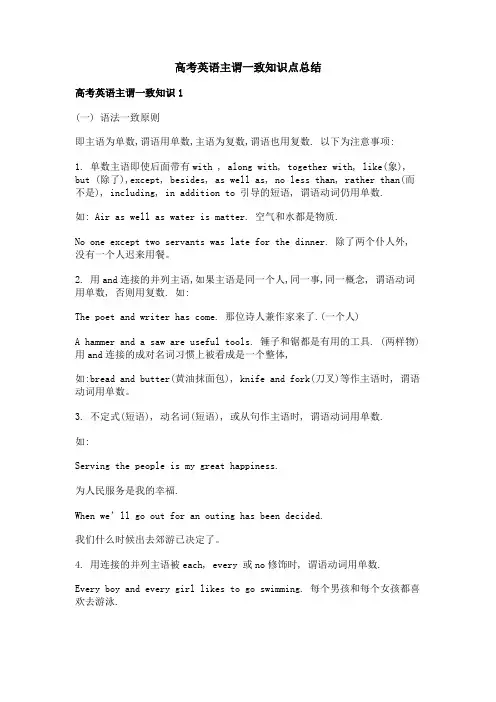
高考英语主谓一致知识点总结高考英语主谓一致知识1(一) 语法一致原则即主语为单数,谓语用单数,主语为复数,谓语也用复数. 以下为注意事项:1. 单数主语即使后面带有with , along with, together with, like(象), but (除了),except, besides, as well as, no less than, rather than(而不是), including, in addition to 引导的短语, 谓语动词仍用单数.如: Air as well as water is matter. 空气和水都是物质.No one except two servants was late for the dinner. 除了两个仆人外, 没有一个人迟来用餐。
2. 用and连接的并列主语,如果主语是同一个人,同一事,同一概念, 谓语动词用单数, 否则用复数. 如:The poet and writer has come. 那位诗人兼作家来了.(一个人)A hammer and a saw are useful tools. 锤子和锯都是有用的工具. (两样物)用and连接的成对名词习惯上被看成是一个整体,如:bread and butter(黄油抹面包), knife and fork(刀叉)等作主语时, 谓语动词用单数。
3. 不定式(短语), 动名词(短语), 或从句作主语时, 谓语动词用单数.如:Serving the people is my great happiness.为人民服务是我的幸福.When we’ll go out for an outing has been decided.我们什么时候出去郊游已决定了。
4. 用连接的并列主语被each, every 或no修饰时, 谓语动词用单数.Every boy and every girl likes to go swimming. 每个男孩和每个女孩都喜欢去游泳.No teacher and no student was absent from the meeting. 没有老师也没有学生开会缺席.Each man and (each) woman is asked to help. 每个男人和每个女人都被请去帮忙。

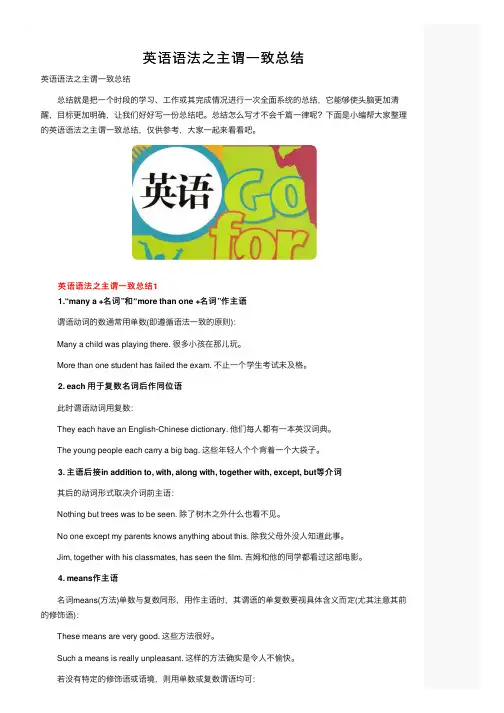
英语语法之主谓⼀致总结英语语法之主谓⼀致总结 总结就是把⼀个时段的学习、⼯作或其完成情况进⾏⼀次全⾯系统的总结,它能够使头脑更加清醒,⽬标更加明确,让我们好好写⼀份总结吧。
总结怎么写才不会千篇⼀律呢?下⾯是⼩编帮⼤家整理的英语语法之主谓⼀致总结,仅供参考,⼤家⼀起来看看吧。
英语语法之主谓⼀致总结1 1.“many a +名词”和“more than one +名词”作主语 谓语动词的数通常⽤单数(即遵循语法⼀致的原则): Many a child was playing there. 很多⼩孩在那⼉玩。
More than one student has failed the exam. 不⽌⼀个学⽣考试未及格。
2. each ⽤于复数名词后作同位语 此时谓语动词⽤复数: They each have an English-Chinese dictionary. 他们每⼈都有⼀本英汉词典。
The young people each carry a big bag. 这些年轻⼈个个背着⼀个⼤袋⼦。
3. 主语后接in addition to, with, along with, together with, except, but等介词 其后的动词形式取决介词前主语: Nothing but trees was to be seen. 除了树⽊之外什么也看不见。
No one except my parents knows anything about this. 除我⽗母外没⼈知道此事。
Jim, together with his classmates, has seen the film. 吉姆和他的同学都看过这部电影。
4. means作主语 名词means(⽅法)单数与复数同形,⽤作主语时,其谓语的单复数要视具体含义⽽定(尤其注意其前的修饰语): These means are very good. 这些⽅法很好。

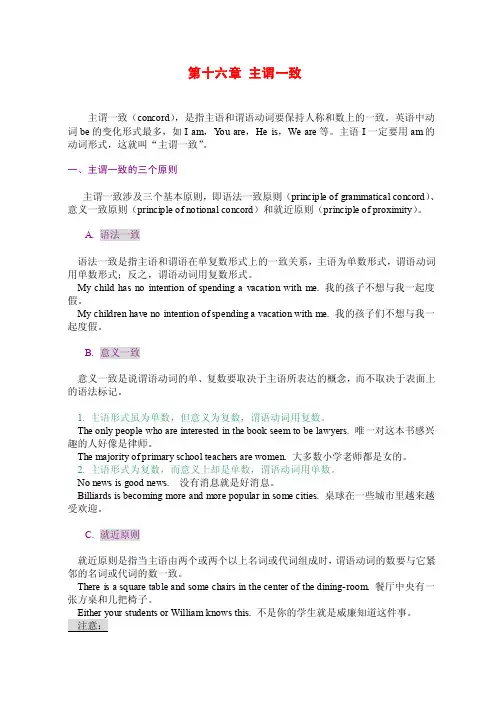
第十六章主谓一致主谓一致(concord),是指主语和谓语动词要保持人称和数上的一致。
英语中动词be的变化形式最多,如I am,Y ou are,He is,We are等。
主语I一定要用am的动词形式,这就叫“主谓一致”。
一、主谓一致的三个原则主谓一致涉及三个基本原则,即语法一致原则(principle of grammatical concord)、意义一致原则(principle of notional concord)和就近原则(principle of proximity)。
A.语法一致语法一致是指主语和谓语在单复数形式上的一致关系,主语为单数形式,谓语动词用单数形式;反之,谓语动词用复数形式。
My child has no intention of spending a vacation with me. 我的孩子不想与我一起度假。
My children have no intention of spending a vacation with me. 我的孩子们不想与我一起度假。
B.意义一致意义一致是说谓语动词的单、复数要取决于主语所表达的概念,而不取决于表面上的语法标记。
1. 主语形式虽为单数,但意义为复数,谓语动词用复数。
The only people who are interested in the book seem to be lawyers. 唯一对这本书感兴趣的人好像是律师。
The majority of primary school teachers are women. 大多数小学老师都是女的。
2. 主语形式为复数,而意义上却是单数,谓语动词用单数。
No news is good news. 没有消息就是好消息。
Billiards is becoming more and more popular in some cities. 桌球在一些城市里越来越受欢迎。
C.就近原则就近原则是指当主语由两个或两个以上名词或代词组成时,谓语动词的数要与它紧邻的名词或代词的数一致。

英语主谓一致的三个原则英语中的主谓一致是指主语和谓语在人称(第一人称、第二人称和第三人称)、数(单数和复数)和人称(第一人称、第二人称和第三人称)方面要保持一致。
下面是主谓一致的三个原则:1.第一人称主语与谓语动词保持一致:当主语是第一人称,即指说话人自己时,谓语动词要用第一人称的形式,即单数一致。
例如:- I am going to the store.(我要去商店。
)- We are going to the store.(我们要去商店。
)2.以及第二人称主语与谓语动词保持一致:当主语是第二人称,即指与说话人进行交流的人时,谓语动词要用第二人称的形式,即单数或复数一致。
例如:- You are my best friend.(你是我最好的朋友。
)- You all are my best friends.(你们都是我最好的朋友。
)3.并且第三人称主语与谓语动词保持一致:当主语是第三人称,即指除了说话人和听话人之外的其他人或物时,谓语动词要用第三人称的形式,根据主语的单复数来确定。
例如:- He is going to the store.(他要去商店。
)- They are going to the store.(他们要去商店。
)需要注意的是,存在一些特殊情况需要特别注意:- 当主语由连接词"and"连接时,如果主语是两个单数名词,则谓语动词要用复数形式;如果主语是一个单数名词和一个复数名词,则谓语动词要与靠近它的名词保持一致。
例如:- Tom and Jerry are playing soccer.(汤姆和杰瑞正在踢足球。
)- The cat and the dogs are eating.(猫和狗正在吃饭。
)- 当主语是由 either...or 或 neither...nor 连接时,谓语动词要与靠近它的名词保持一致。
例如:- Neither John nor his friends are going to the party.(约翰和他的朋友们都不去参加派对。
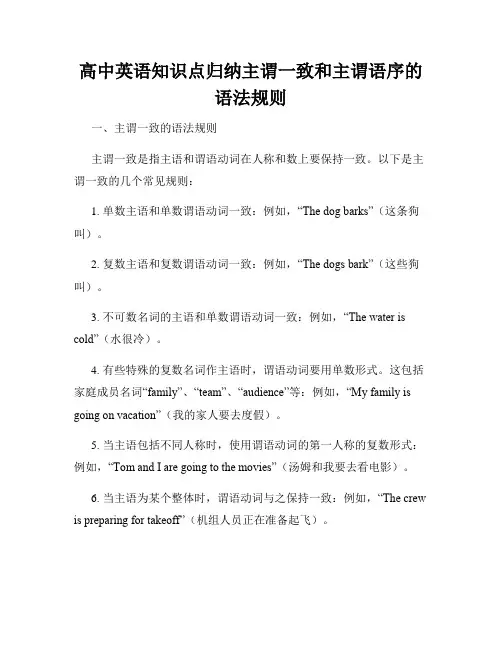
高中英语知识点归纳主谓一致和主谓语序的语法规则一、主谓一致的语法规则主谓一致是指主语和谓语动词在人称和数上要保持一致。
以下是主谓一致的几个常见规则:1. 单数主语和单数谓语动词一致:例如,“The dog barks”(这条狗叫)。
2. 复数主语和复数谓语动词一致:例如,“The dogs bark”(这些狗叫)。
3. 不可数名词的主语和单数谓语动词一致:例如,“The water is cold”(水很冷)。
4. 有些特殊的复数名词作主语时,谓语动词要用单数形式。
这包括家庭成员名词“family”、“team”、“audience”等:例如,“My family is going on vacation”(我的家人要去度假)。
5. 当主语包括不同人称时,使用谓语动词的第一人称的复数形式:例如,“Tom and I are going to the movies”(汤姆和我要去看电影)。
6. 当主语为某个整体时,谓语动词与之保持一致:例如,“The crew is preparing for takeoff”(机组人员正在准备起飞)。
7. 当主语中包括“each”、“every”、“either”、“neither”、“everyone”、“nobody”等词时,谓语动词用单数形式:例如,“Every student has to submit their homework”(每个学生都必须提交他们的作业)。
二、主谓语序的语法规则主谓语序指的是主语和谓语动词的顺序要保持一致。
以下是主谓语序的几个常见规则:1. 在陈述句中,主语通常位于谓语动词之前:例如,“She is a teacher”(她是一名老师)。
2. 在疑问句中,将谓语动词放在主语之前:例如,“Are you hungry?”(你饿了吗?)。
3. 在祈使句中,主语通常省略,谓语动词单独出现:例如,“Sit down”(坐下)。
4. 在条件句中,主语通常位于谓语动词之前:例如,“If it rains, we will stay indoors”(如果下雨,我们就呆在室内)。
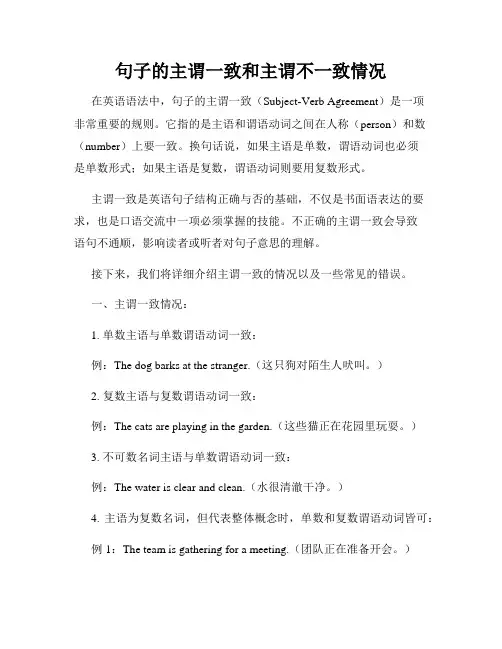
句子的主谓一致和主谓不一致情况在英语语法中,句子的主谓一致(Subject-Verb Agreement)是一项非常重要的规则。
它指的是主语和谓语动词之间在人称(person)和数(number)上要一致。
换句话说,如果主语是单数,谓语动词也必须是单数形式;如果主语是复数,谓语动词则要用复数形式。
主谓一致是英语句子结构正确与否的基础,不仅是书面语表达的要求,也是口语交流中一项必须掌握的技能。
不正确的主谓一致会导致语句不通顺,影响读者或听者对句子意思的理解。
接下来,我们将详细介绍主谓一致的情况以及一些常见的错误。
一、主谓一致情况:1. 单数主语与单数谓语动词一致:例:The dog barks at the stranger.(这只狗对陌生人吠叫。
)2. 复数主语与复数谓语动词一致:例:The cats are playing in the garden.(这些猫正在花园里玩耍。
)3. 不可数名词主语与单数谓语动词一致:例:The water is clear and clean.(水很清澈干净。
)4. 主语为复数名词,但代表整体概念时,单数和复数谓语动词皆可:例1:The team is gathering for a meeting.(团队正在准备开会。
)例2:The team are discussing their plans.(团队正在讨论他们的计划。
)5. 主语为由and连接的两个名词时,根据意思来确定谓语动词的单复数形式:例1:Bread and butter is my favorite breakfast.(面包和黄油是我最喜欢的早餐。
)例2:Tom and Jerry are good friends.(汤姆和杰里是好朋友。
)二、主谓不一致情况:1. 不正确的主谓一致会导致句子构造错误,如主谓数不一致:例:The cat drinks water from the bowl.(错误:The cat drink water from the bowl.)2. 主语为复数名词时,却使用了单数形式的谓语动词:例:The flowers brings beauty to the garden.(错误:The flowers bring beauty to the garden.)3. 主语为不可数名词时,却使用了复数形式的谓语动词:例:The coffee have a strong aroma.(错误:The coffee has a strong aroma.)4. 主谓一致错误可能会导致混淆和误解的情况:例:The news was shocking.(这个消息令人震惊。
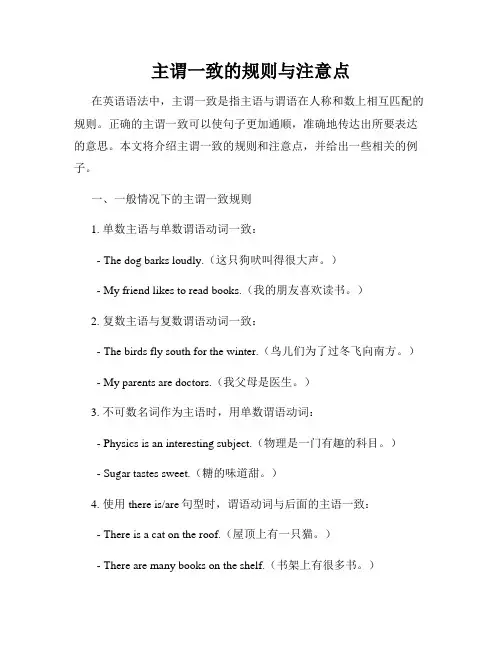
主谓一致的规则与注意点在英语语法中,主谓一致是指主语与谓语在人称和数上相互匹配的规则。
正确的主谓一致可以使句子更加通顺,准确地传达出所要表达的意思。
本文将介绍主谓一致的规则和注意点,并给出一些相关的例子。
一、一般情况下的主谓一致规则1. 单数主语与单数谓语动词一致:- The dog barks loudly.(这只狗吠叫得很大声。
)- My friend likes to read books.(我的朋友喜欢读书。
)2. 复数主语与复数谓语动词一致:- The birds fly south for the winter.(鸟儿们为了过冬飞向南方。
) - My parents are doctors.(我父母是医生。
)3. 不可数名词作为主语时,用单数谓语动词:- Physics is an interesting subject.(物理是一门有趣的科目。
)- Sugar tastes sweet.(糖的味道甜。
)4. 使用there is/are句型时,谓语动词与后面的主语一致:- There is a cat on the roof.(屋顶上有一只猫。
)- There are many books on the shelf.(书架上有很多书。
)二、特殊情况下的主谓一致规则1. 当主语由“each”, “every”, “either”, “neither”等修饰时,谓语动词用单数形式:- Each student needs to bring their own pen.(每个学生都需要带上自己的钢笔。
)- Neither of them is available tomorrow.(他们中的任何一个明天都不可用。
)2. 当主语由“either...or”, “neither...nor”, “not only...but also”等连接时,谓语动词与最靠近的主语一致:- Either the cat or the dogs are sleeping.(要么猫要么狗正在睡觉。
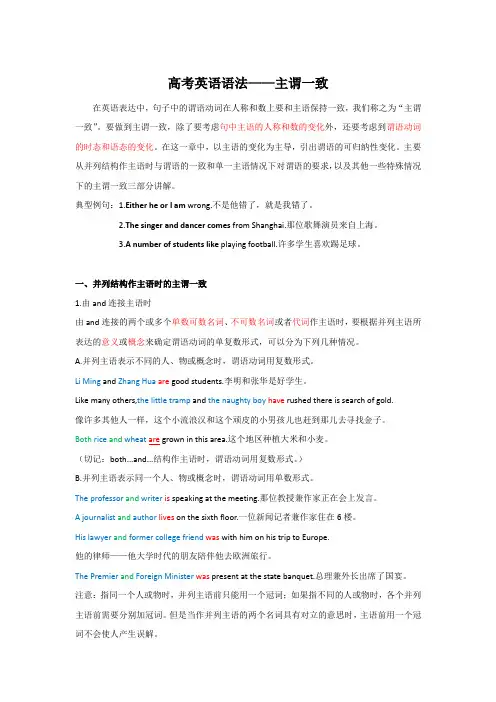
高考英语语法——主谓一致在英语表达中,句子中的谓语动词在人称和数上要和主语保持一致,我们称之为“主谓一致”。
要做到主谓一致,除了要考虑句中主语的人称和数的变化外,还要考虑到谓语动词的时态和语态的变化。
在这一章中,以主语的变化为主导,引出谓语的可归纳性变化。
主要从并列结构作主语时与谓语的一致和单一主语情况下对谓语的要求,以及其他一些特殊情况下的主谓一致三部分讲解。
典型例句:1.Either he or I am wrong.不是他错了,就是我错了。
2.The singer and dancer comes from Shanghai.那位歌舞演员来自上海。
3.A number of students like playing football.许多学生喜欢踢足球。
一、并列结构作主语时的主谓一致1.由and连接主语时由and连接的两个或多个单数可数名词、不可数名词或者代词作主语时,要根据并列主语所表达的意义或概念来确定谓语动词的单复数形式,可以分为下列几种情况。
A.并列主语表示不同的人、物或概念时,谓语动词用复数形式。
Li Ming and Zhang Hua are good students.李明和张华是好学生。
Like many others,the little tramp and the naughty boy have rushed there is search of gold.像许多其他人一样,这个小流浪汉和这个顽皮的小男孩儿也赶到那儿去寻找金子。
Both rice and wheat are grown in this area.这个地区种植大米和小麦。
(切记:both...and...结构作主语时,谓语动词用复数形式。
)B.并列主语表示同一个人、物或概念时,谓语动词用单数形式。
The professor and writer is speaking at the meeting.那位教授兼作家正在会上发言。
主谓一致的规则及应用主谓一致是英语语法中的基本规则,指的是主语与谓语在人称和数上保持一致。
正确运用主谓一致规则会增强句子的准确性和流畅性,使表达更加清晰。
本文将介绍主谓一致的规则,并给出一些应用实例。
一、基本规则1. 单数主语与单数谓语动词一致。
例如:- The cat is sleeping.(这只猫在睡觉。
)- She runs every morning.(她每天早上跑步。
)2. 复数主语与复数谓语动词一致。
例如:- The students are studying in the library.(学生们正在图书馆学习。
)- They play football every weekend.(他们每个周末踢足球。
)3. 不可数名词作主语时,谓语动词通常使用单数形式。
例如:- Rice is a staple food in many countries.(米饭是许多国家的主食。
)- Water is essential for life.(水对生命至关重要。
)4. 用作主语的不定代词通常与单数谓语动词一致。
例如:- Everyone wants to be happy.(每个人都想要快乐。
)- Somebody has left their bag here.(有人把包落在这里了。
)5. 连接词and连接的两个主语,谓语动词通常与复数一致。
例如:- Tom and Jerry are good friends.(汤姆和杰瑞是好朋友。
)- My mom and dad like gardening.(我爸爸妈妈喜欢园艺。
)二、特殊情况1. 数量词、百分数加名词短语作主语时,谓语动词取决于名词短语中的名词单复数形式。
例如:- Fifty percent of the students are girls.(百分之五十的学生是女孩。
)- A lot of money has been spent on this project.(这个项目花费了很多钱。
初中英语语法主谓一致主谓一致是英语语法中的一个重要概念,指的是主语和谓语在人称和数上保持一致。
正确的主谓一致能够使句子更加准确、通顺,增加文章的可读性。
本文将详细介绍初中英语语法中的主谓一致规则及其应用。
一、基本规则1. 单数主语的一致性:单数主语与单数谓语动词一致,即主语为第三人称单数时,谓语动词要加上-s或-es。
例句:My brother goes to school every day.2. 复数主语的一致性:复数主语与复数谓语动词一致,即主语为第三人称复数时,谓语动词不加-s或-es。
例句:The students play soccer in the playground.3. 第一人称代词的一致性:第一人称代词(I和we)作为主语时,谓语动词不加任何变化。
例句:We live in a big city.二、特殊情况1. 连系动词的一致性:连系动词(be动词、seem、appear等)后的表语与前面的主语保持一致。
例句:She is my best friend.2. 复数名词作主语时,要注意其是否看作一个整体,进而确定谓语动词的单复数形式。
例句:A pair of glasses is on the table.(看作一个整体)A pair of glasses are broken.(看作分开的两个镜片)3. 复合主语的一致性:多个并列主语连用时,谓语动词与离它最近的主语保持一致。
例句:My dad and I go shopping every weekend.三、注意事项1. 某些名词虽然以复数形式出现,但指的是单一事物,谓语动词应该用单数形式。
例句:Physics is my favorite subject.2. 集体名词既可以看作整体,也可以看作个体。
若看作整体,则谓语动词用单数形式;若看作个体,则谓语动词用复数形式。
例句:The team is practicing for the competition.(看作整体)The team are arguing with each other.(看作个体)3. 某些名词在作主语时,谓语动词的单复数形式并没有固定规则,需要根据实际语义判断。
初中英语语法——主谓一致讲解及练习主谓一致是指句子中的主语与谓语在人称和数上要保持一致。
掌握主谓一致的规则能够帮助我们正确使用英语语法,使句子结构更加准确和流畅。
下面将对主谓一致进行讲解,并提供一些练题供大家练。
主谓一致的基本规则1. 单数主语+单数谓语动词:当主语是单数时,谓语动词应该使用单数形式。
例如:He eats an apple every day.单数主语+单数谓语动词:当主语是单数时,谓语动词应该使用单数形式。
例如:He eats an apple every day.2. 复数主语+复数谓语动词:当主语是复数时,谓语动词应该使用复数形式。
例如:They eat apples every day.复数主语+复数谓语动词:当主语是复数时,谓语动词应该使用复数形式。
例如:They eat apples every day.3. 不以-s, -es, -ies结尾的复数主语,还原为单数形式+单数谓语动词:当主语是不以-s, -es, -ies结尾的复数名词时,谓语动词应使用单数形式。
例如:My family is going on a trip this weekend.不以-s, -es, -ies结尾的复数主语,还原为单数形式+单数谓语动词:当主语是不以-s, -es, -ies结尾的复数名词时,谓语动词应使用单数形式。
例如:My family is going on a trip this weekend.4. 以-s, -es, -ies结尾的复数主语,使用复数谓语动词:当主语是以-s, -es, -ies结尾的复数名词时,谓语动词应使用复数形式。
例如:The cats play in the garden.以-s, -es, -ies结尾的复数主语,使用复数谓语动词:当主语是以-s, -es, -ies结尾的复数名词时,谓语动词应使用复数形式。
例如:The cats play in the garden.5. 连接词and连接的两个主语,使用复数谓语动词:当两个主语被连接词and连在一起时,谓语动词应使用复数形式。
高考英语复习专题10 主谓一致知识点归纳总结主谓一致(concord),是指主语和谓语动词要保持人称和数上的一致。
英语中动词be的变化形式最多,如I am,You are,He is,We are等。
主语I一定要用am的动词形式,这就叫“主谓一致”。
一、主谓一致的三个原则主谓一致涉及三个基本原则,即语法一致原则(principle of grammatical concord)、意义一致原则(principle of notional concord)和就近原则(principle of proximity)。
A. 语法一致语法一致是指主语和谓语在单复数形式上的一致关系,主语为单数形式,谓语动词用单数形式;反之,谓语动词用复数形式。
My child has no intention of spending a vacation with me. 我的孩子不想与我一起度假。
My children have no intention of spending a vacation with me. 我的孩子们不想与我一起度假。
B. 意义一致意义一致是说谓语动词的单、复数要取决于主语所表达的概念,而不取决于表面上的语法标记。
1. 主语形式虽为单数,但意义为复数,谓语动词用复数。
The only people who are interested in the book seem to be lawyers. 唯一对这本书感兴趣的人好像是律师。
The majority of primary school teachers are women. 大多数小学老师都是女的。
2. 主语形式为复数,而意义上却是单数,谓语动词用单数。
No news is good news. 没有消息就是好消息。
Billiards is becoming more and more popular in some cities. 桌球在一些城市里越来越受欢迎。
高中英语语法——主谓一致含专项练习及答案解析一、主谓一致的三个原则主谓一致涉及三个基本原则,即语法一致原则、意义一致原则和就近原则。
A. 语法一致语法一致是指主语和谓语在单复数形式上的一致关系,主语为单数形式,谓语动词用单数形式;反之,谓语动词用复数形式。
My child has no intention of spending a vacation with me. 我的孩子不想与我一起度假。
My children have no intention of spending a vacation with me. 我的孩子们不想与我一起度假。
B. 意义一致意义一致是说谓语动词的单、复数要取决于主语所表达的概念,而不取决于表面上的语法标记。
1. 主语形式虽为单数,但意义为复数,谓语动词用复数。
The only people who are interested in the book seem to be lawyers. 唯一对这本书感兴趣的人好像是律师。
The majority of primary school teachers are women. 大多数小学老师都是女的。
2. 主语形式为复数,而意义上却是单数,谓语动词用单数。
No news is good news. 没有消息就是好消息。
Billiards is becoming more and more popular in some cities. 桌球在一些城市里越来越受欢迎。
C. 就近原则就近原则是指当主语由两个或两个以上名词或代词组成时,谓语动词的数要与它紧邻的名词或代词的数一致。
There is a square table and some chairs in the center of the dining-room. 餐厅中央有一张方桌和几把椅子。
Either your students or William knows this. 不是你的学生就是威廉知道这件事。
主谓一致语法一致原则在英语语法中,主谓一致是指主语和谓语在人称和数上要保持一致。
这是一条基本的语法规则,也是英语句子正确表达的重要要素之一。
主谓一致语法一致原则在写作中起到了重要的作用,使句子更加清晰、准确、易于理解。
主谓一致语法一致原则可以应用于不同的句子结构和各种时态。
在下面的几个例子中,我们将详细介绍这一原则的应用。
1. 一般现在时在一般现在时中,主谓一致的原则是:单数主语使用单数谓语动词,复数主语使用复数谓语动词。
例如:- The cat sleeps on the sofa. (猫在沙发上睡觉。
)- The students study hard for the exam. (学生们为了考试努力学习。
)2. 现在进行时在现在进行时中,主谓一致的原则是:单数主语使用单数谓语动词+ing形式,复数主语使用复数谓语动词+ing形式。
例如:- She is watching TV. (她正在看电视。
)- They are playing basketball. (他们正在打篮球。
)3. 一般过去时在一般过去时中,主谓一致的原则是:不论主语是单数还是复数,谓语动词都使用过去式。
例如:- He visited his grandparents last week. (他上周去看望了他的祖父母。
)- They played soccer in the park yesterday. (他们昨天在公园里踢足球。
)4. 过去进行时在过去进行时中,主谓一致的原则是:不论主语是单数还是复数,谓语动词都使用过去式+ing形式。
例如:- She was reading a book when I called her. (我给她打电话的时候她正在读书。
)- They were having dinner when the power went out. (停电的时候他们正在吃晚饭。
)5. 将来时在将来时中,主谓一致的原则是:不论主语是单数还是复数,谓语动词都使用将来时态的形式。
英语语法单一主语的主谓一致单一主语的主谓一致单数的主语跟单数的动词,复数的主语跟复数的动词,这是符合语法一致的原则。
但在实际运用中,往往会出现较为复杂的情况:A.形复意单的名词作主语形复意单的名词作主语(即形式为复数,意义为单数),按意义一致的原则,用作单数意义时,谓语用单数,反之,谓语用复数。
1. 许多学科名称,如mathematics, physics, economics, politics 等,以及news等名词作主语时,动词用单数。
Physics is required of every student in our school. 物理是我校每个学生的必修科目。
News is traveling fast nowadays. 当今新闻传播得很快。
2. 用作国名、组织机构、书名、报刊名等复数形式的专有名词作为整体对待,谓语用单数。
The United Nations has passed a resolution to lift sanctions against Iraq. 联合国通过了解除对伊制裁的决定。
The Times reports the news of the strike. 时代杂志报导了罢工的消息。
Great Expectations was written by Dickens in 1860. 《远大前程》是狄更斯于1860年写的。
注意:如果山脉、群岛、瀑布等名称作主语时,谓语动词用复数。
The Great Lakes lie between the USA and Canada. 五大湖在美国和加拿大两国之间。
The Philippines are in the western Pacific Ocean southeast of China. 菲律宾群岛在中国东南太平洋西部。
The Niagara Falls are the falls on the Niagara River. 尼亚加拉瀑布位于尼亚加拉河上。
3. 一些形复意单的名词,包括有成双成套部分的衣物或工具名称,作主语时,谓语用复数。
My blue trousers have been worn out. 我的蓝裤子已经穿破了。
His glasses are new. 他的眼镜是新的。
注意:这些名词如用a pair of 修饰时,谓语动词用单数。
The shoes are under the bed. 鞋在床下。
The pair of shoes is under the bed. 这双鞋在床下。
4. 单、复数同形名词作主语时,按意义一致的原则,用作单数意义时,谓语用单数;用作复数意义时,谓语用复数。
这类名词有:sheep, deer, fish, means, works, species, Chinese, Japanese等。
The (This) glass works was set up in 1986. 这家玻璃厂建于1986年。
The (These) glass works are near the railway station. 这些玻璃厂在火车站附近。
This species of rose is very rare. 这种玫瑰很稀有。
The species of fish are numerous. 鱼的种类很多。
Sheep are raised for wool. 养羊是为了剪毛。
There is a sheep under the tree. 树下有一只绵羊。
比较:当这类名词前有a, such a, this, that, every修饰时,谓语用单数;有all, such, these, those修饰时,谓语用复数。
Every means has been tried out without much result. 每一种方法都试过了却没什么结果。
All means have been tried out without much result. 所有方法都试过了却没什么结果。
B.集合名词作主语集合名词表示有若干个体组成的集合体,如army, audience, class, club, company, crowd, government, group, party, population, team, union等。
1. 集合名词作主语时,若表示整体概念,谓语动词用单数,若表示构成该集合体的成员,则谓语动词用复数。
His family are waiting for him. 他的家人正在等他。
But the man's family was small-only himself and his wife. 但那人的家庭很小,只有他本人和妻子。
One third of the population here are workers. 这里人口中有三分之一是工人。
The population of the earth is increasing every year. 地球上的人口每年都在增长。
2. 有些集合名词,如cattle, folk, people, police, youth等,作主语时,谓语动词用复数,即所谓的“形单意复”。
The police have caught the thief. 警察已经抓住了小偷。
The cattle are grazing in the field. 牛在田野里吃草。
Youth today are quite different from 20 years ago. 现在的年轻人和20年前大不一样。
Some folk are never satisfied. 有些人从不知足。
比较:几组集合名词作主语的句子。
The team is well organized. 这个队组织得很好。
The team are all tough players. 这个队的队员都很强壮。
All the class were jumping with joy. 全班同学都高兴地跳了起来。
The class is made up of 54 students. 这班由54名学生组成。
The young couple is happy. 这对年轻夫妇很幸福。
The young couple are quarrelling with each other. 这对年轻夫妇正在吵架。
The village is at the foot of the mountain. 这个村子在山脚下。
All the village are out to greet him. 全村人都出来欢迎他。
3.有些无生命(表示物)的集合名词作主语,谓语用单数。
All the furniture in my room is new. 我房间里的家具都是新的。
Warm clothing is necessary in cold climates. 在寒冷的气候中,保暖的衣服是必需的。
The machinery is driven by electricity. 这些机器是由电力驱动的。
Has your luggage arrived yet 你的行李已经运到了吗?A lot of hiking equipment is needed here. 这里需要大量徒步旅行的装备。
C.代词作主语1.名词性物主代词作主语时,既可以用作单数,也可以用作复数,这取决于它所代替的是单数还是复数。
Ours is a great country. 我们的(国家)是一个伟大的国家。
(ours = our country)Your shoes are black, and mine are brown. 你的鞋是黑色的,我的(鞋)是棕色的。
( mine=my shoes)2.such, the same等指示代词作主语时,应根据其所指的内容来决定单、复数。
Such was Albert Einstein, a simple man with great achievements. 爱因斯坦就是这样一个俭朴而又取得巨大成就的人。
Such are her wishes. 她的愿望就这些。
3.关系代词who, that, which等在定语从句中作主语时,其谓语动词的数应与主句中先行词的数一致。
Those who want to go for a picnic please put up your hands. 那些想去野餐的人请举手。
Some of the energy that is used by man comes from the sun. 一些被人类使用的能量来自于太阳注意:在one of+复数名词+whothatwhich 引导的定语从句结构中,关系代词whothatwhich的先行词是靠近它的复数名词而不是one,因此,从句中的动词应该是复数形式。
但当one之前有the, the only 等修饰语时,关系代词的先行词是one,而不是靠近它的复数名词,因此从句的动词应是单数形式。
This is one of the best films that have been shown this year. 这是今年所放的最佳电影中的一部。
She is the only one of the girls who sings best. 她是这么多女孩中唯一歌唱得最好的。
4.疑问代词who, what, which作主语时,谓语动词可根据说话人所要表达的意思决定单、复数。
Who lives upstairs It is Xiao Wang. 谁住在楼上?小王。
Who live next door It is Li and Zhang. 谁住在隔壁?李和张。
5.不定代词作主语时,有以下两种情况:①some, all, any, none, more, most等词可以指复数名词和不可数名词,它们作主语时,视其文中的意义,判断动词用单数还是复数的形式。
Now all has been changed. 一切都已改变。
All are present today, Mr Li. answered the monitor. 班长回答说:李老师,今天大家全到了。
None is so good as he. 没有人像他那么好。
None are so good as those who are always ready to help others. 没有人像那些总是乐于助人的人那么好。
提示:在口语中,none of + 复数名词作主语,谓语动词用单数或复数均可,要以说话人所想的而定。